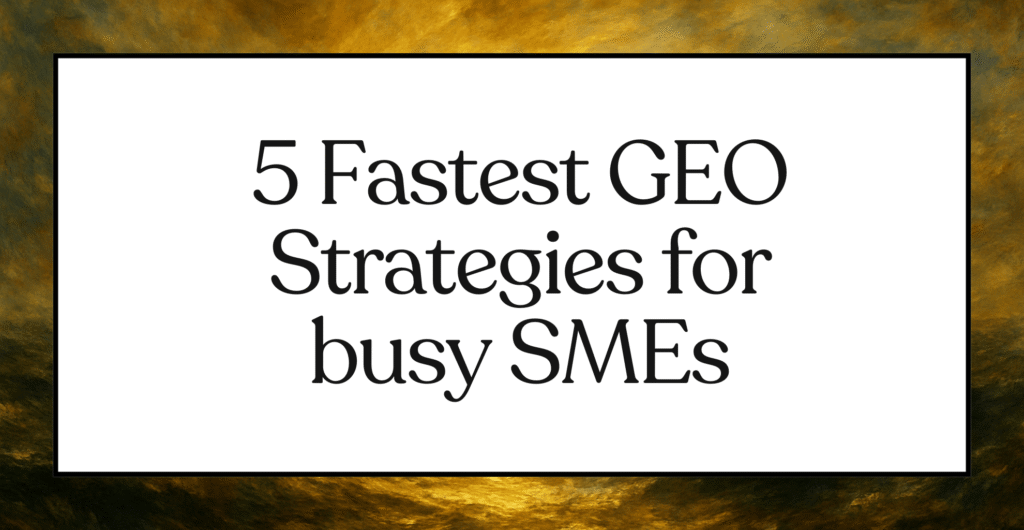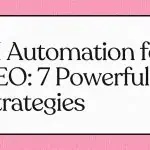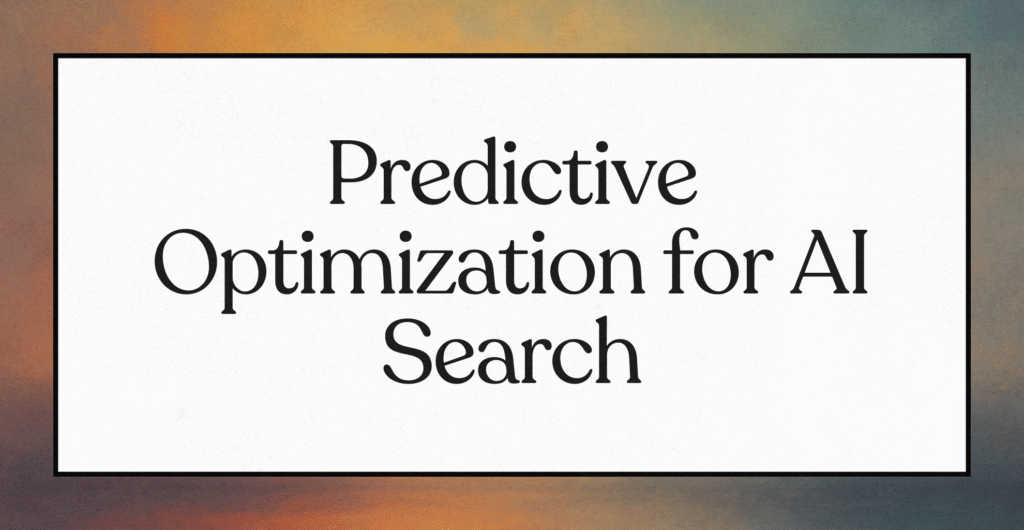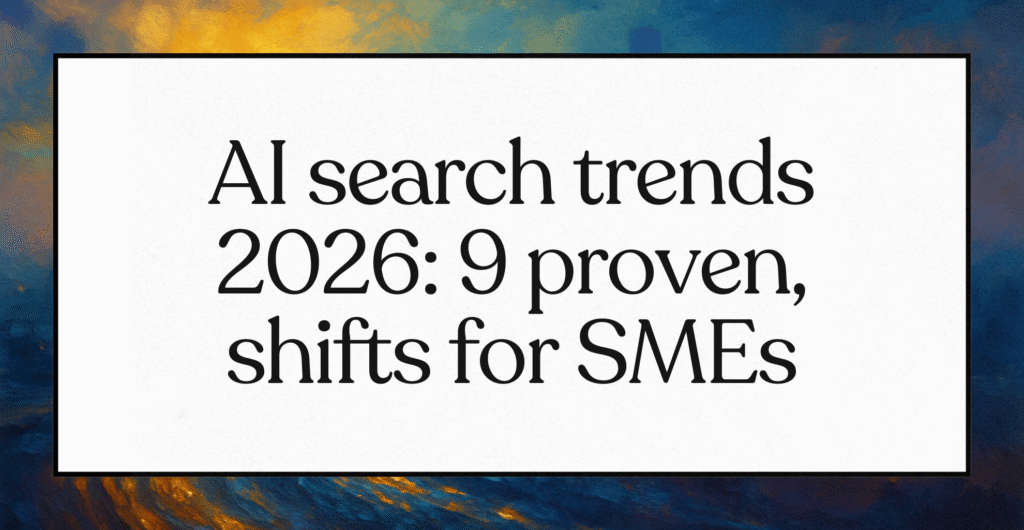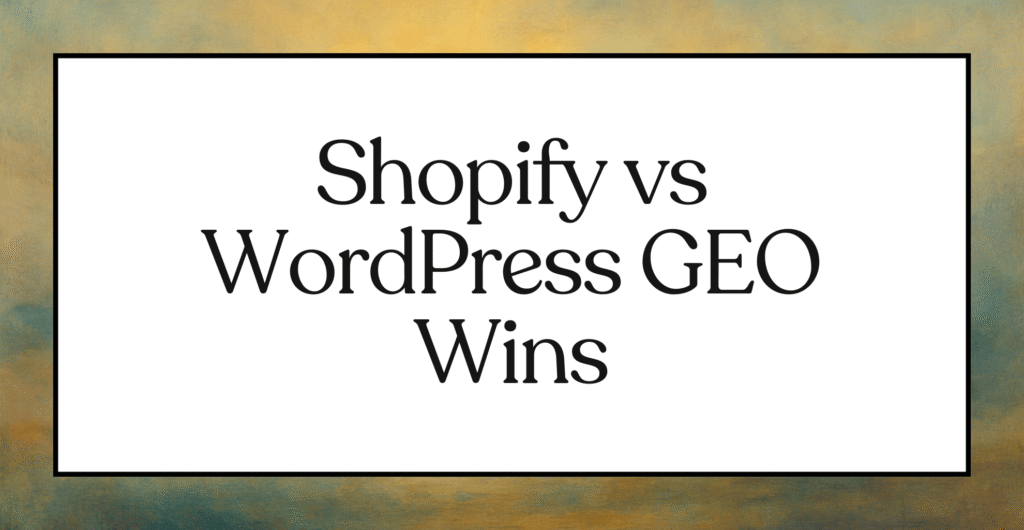Summary
Generative Engine Optimization shifts strategy from ranking for keywords to earning citations inside AI answers across ChatGPT, Google AI Overviews, Perplexity, Gemini, and Claude, delivering faster visibility for SMEs with proof points like a 540% surge in AI Overviews mentions and 6X to 27X higher conversion rates from LLM traffic. The playbook centers on structured data and schema markup, earned media authority and Reddit presence, conversational content aligned to natural language questions, entity optimization for knowledge graphs, and open crawler access via robots.txt, with results emerging in 6 to 12 weeks and often within 30 to 90 days for prioritized actions. Measurement relies on citation frequency, visibility score, sentiment, and share of voice, with manual weekly query audits as a low-cost baseline and platforms like Otterly.AI and Athena HQ for scalable tracking.
LS Building Products achieved a 540% increase in Google AI Overviews mentions within six months by restructuring their content architecture around conversational queries instead of traditional keywords. That single shift transformed a manufacturing company facing invisibility in AI-powered search engines into the top recommendation when architects asked ChatGPT about moisture-resistant materials. For African SMEs and global small businesses operating with tight budgets and small teams, understanding which Generative Engine Optimization strategies deliver the fastest results has become a survival imperative as traditional search traffic declines 25% year-over-year.
This guide examines proven GEO techniques that time-pressed businesses can implement immediately, the fundamental differences between AI-powered and traditional search optimization, and practical measurement frameworks that work without enterprise-level budgets.
What Is Generative Engine Optimization and Why Does It Matter?
Generative Engine Optimization represents the practice of creating and structuring content so AI systems like ChatGPT, Perplexity, Gemini, and Claude cite your brand when generating conversational answers. Unlike traditional SEO, which aims to rank web pages in search results lists, GEO focuses on becoming the authoritative source that AI engines reference when synthesizing responses to natural language queries.
ChatGPT reached 400 million weekly active users as of February 2025, while Google’s AI Overviews now appear on at least 13% of all search engine results pages. Research from Y Combinator forecasts a 25% decline in traditional search engine volume by 2026 and a 50% decline by 2028 as users shift to conversational AI interfaces. For businesses, this means the decision-making process increasingly happens before a potential customer ever visits your website, with 89% of B2B buyers now using AI platforms for research.
The economic implications are substantial: traffic from large language models converts at 6X to 27X the rate of traditional search traffic because AI pre-qualifies user intent during the conversation. When Webflow analyzed their acquisition channels, they discovered that 8% of total signups originated from LLMs, with conversion rates six times higher than Google search traffic. African SMEs facing resource constraints benefit disproportionately from this conversion quality advantage, as smaller traffic volumes with higher intent deliver better ROI than competing for expensive paid advertising.
How Does GEO Differ from Traditional SEO for AI-Powered Search?
The fundamental distinction between Generative Engine Optimization strategies and traditional SEO lies in the success metric: citations versus clicks. Traditional search optimization targeted ranking position on results pages, measuring success through impressions, click-through rates, and page visits. AI-powered search optimization focuses on appearing within the generated answer itself, where success means being referenced as an authoritative source regardless of whether users click through.
| Aspect | Traditional SEO | Generative Engine Optimization |
|---|---|---|
| Primary Goal | Rank in top 10 results | Be cited in AI-generated answers |
| Success Metric | Click-through rate | Citation frequency across AI platforms |
| Content Format | Keyword-optimized pages | Conversational, structured responses |
| Authority Signals | Backlinks from other sites | Brand mentions + community presence + earned media |
| Technical Foundation | Crawlability, site speed | Schema markup, structured data, AI crawler access |
| Timeline to Results | 3-6 months minimum | 6-12 weeks for initial citations |
This table illustrates why businesses with strong traditional SEO foundations possess advantages when implementing Generative Engine Optimizations techniques, as the underlying principles of authoritative content and technical accessibility remain valuable. However, AI engines evaluate authority differently, weighing community mentions on Reddit and user-generated content platforms nearly as heavily as traditional backlinks.
African SMEs face unique constraints including inconsistent connectivity, limited access to expensive tools, and underrepresentation in US-centric content databases. The advantage Generative Engine Optimization strategies offer these businesses is speed: properly structured content can earn AI citations within weeks rather than the months required to build domain authority through traditional link-building campaigns.
Which Specific GEO Strategies Deliver the Fastest Visibility Improvements?
Analysis of successful implementations across multiple industries reveals five techniques that consistently produce measurable results within 30-90 days.
Structured Data and Schema Markup Implementation
Schema markup gives AI engines machine-readable context about your content’s purpose and structure. Research conducted across hundreds of websites found that pages with FAQ schema or HowTo schema achieve 30-40% higher visibility in AI-generated answers compared to equivalent content without structured data.
The fastest implementation path involves adding FAQ schema to existing service pages and blog posts that answer common questions, HowTo schema for any procedural or instructional content, Product schema with detailed specifications for e-commerce sites, and Organization schema establishing your business entity and credentials. WordPress users can implement these through plugins like Schema Pro or Rank Math, while Shopify stores benefit from built-in structured data support that requires minimal customization.
African businesses should prioritize FAQ schema because it requires no developer resources and can be implemented through free tools within hours. The immediate benefit is that AI engines can extract and cite specific answers from your content when users ask related questions.
Earned Media Authority Building
AI search platforms weight third-party mentions more heavily than self-promotional content, creating advantages for businesses that earn citations in authoritative publications and community discussions. Analysis of AI citation patterns across 11 industries revealed that Reddit receives approximately 66,000 AI mentions, appearing in top-cited URLs across every sector examined.
Practical implementation for resource-constrained SMEs involves identifying 20-50 high-authority articles where competitors are mentioned but your brand is not, contributing genuine expertise to Reddit discussions in relevant subreddits without promotional language, optimizing review profiles on G2, Capterra, or industry-specific platforms with detailed use case descriptions, and reaching out to journalists covering your industry with exclusive data or unique perspectives.
The citation gap strategy delivers disproportionate returns: getting mentioned in a single authoritative comparison article that AI engines already trust can result in your brand appearing across dozens of related queries. One early-stage SaaS company went from zero AI visibility to being cited in 40% of relevant ChatGPT queries within 90 days by systematically securing mentions in 10 high-authority roundup articles.
Conversational Content Optimization
AI engines prefer content structured as direct answers to specific questions rather than keyword-optimized articles targeting search terms. The shift from “healthy meal prep ideas” to “what should I cook for dinner when trying to lose weight” illustrates how conversational queries require different content strategies.
Fast implementation requires auditing customer support tickets and sales calls to identify actual questions prospects ask, creating comprehensive answers that address the specific context behind each question, structuring content with clear headings that match question phrasing, and including direct quotes, statistics, and specific statements that AI systems can extract and cite.
Research demonstrates that pages containing quotes or statistics achieve 30-40% higher visibility in AI answers compared to generic descriptions. Instead of writing “Email marketing can be effective,” structure content as “Email marketing generates an average ROI of $42 for every dollar spent, making it one of the highest-performing channels for SMEs with limited budgets”.
Entity Optimization and Knowledge Graph Presence
AI engines rely on entity recognition to understand relationships between brands, topics, and concepts. When multiple authoritative sources mention your brand alongside specific topics or competitors, AI systems associate your entity with those concepts.
Immediate actions include ensuring consistent NAP (Name, Address, Phone) information across all platforms, creating or claiming knowledge panel entities through Google Business Profile and Wikipedia presence where appropriate, building co-citation patterns by appearing in comparison content alongside established competitors, and establishing clear authorship with author schema and biographical information demonstrating expertise.
For African businesses, establishing entity presence within regional context matters because AI systems recognize geographic and cultural specificity in queries. A South African accounting firm should aim for mentions in ZAR-focused financial content rather than only international sources.
Multi-Platform AI Crawler Access
Many websites accidentally block the bots that AI engines use to discover and index content, creating technical barriers to citation. ChatGPT uses three distinct crawlers: ChatGPT-User for serving queries, OAI-SearchBot for search-enabled features, and GPTBot for training data collection.
Essential technical implementation requires verifying your robots.txt file allows critical AI crawlers including ChatGPT-User, Claude-Web, PerplexityBot, and GoogleOther. Add explicit permissions:
User-agent: ChatGPT-User Allow: / User-agent: Claude-Web Allow: / User-agent: PerplexityBot Allow: /Additionally, ensure primary content loads without JavaScript execution, as most AI crawlers cannot process dynamically rendered content. Check server logs to verify these user agents are successfully crawling your site.
African businesses hosted on shared infrastructure or using aggressive CDN security should specifically whitelist AI bots, as many default configurations block these crawlers alongside malicious traffic.
How Can Businesses Measure and Track GEO Performance Across AI Platforms?
Measuring AI search visibility requires different tools and metrics than traditional analytics platforms. The fundamental Generative Engine Optimizations metrics include citation frequency (how often your brand appears in AI responses), visibility score (percentage of relevant queries where you’re mentioned), sentiment analysis (positive, neutral, or negative context of citations), and share of voice (your citation rate versus competitors)
Core GEO Metrics That Matter
Citation frequency represents the foundational metric, tracking raw mentions across ChatGPT, Perplexity, Claude, and Gemini for queries relevant to your business. Unlike pageviews or impressions, a single citation can influence multiple users as they share or act on the AI-generated recommendation. Visibility score calculates the percentage of priority queries where your brand appears, providing a benchmark for measuring improvement over time.
Conversion attribution from AI sources requires implementing UTM parameters or dedicated tracking that identifies traffic originating from LLM referrals. Webflow’s discovery that 8% of signups came from LLMs only became actionable because they implemented tracking systems that separated this channel from generic referral traffic.
Top GEO Tracking Tools Comparison
Five platforms offer SME-accessible monitoring capabilities with varying price points and feature sets.
| Platform | Best For | Starting Price | Key Differentiator |
|---|---|---|---|
| Otterly.AI | Comprehensive brand monitoring | Contact for pricing | Real-time alerts across multiple AI engines |
| Athena HQ | Citation gap analysis | $99/month | Identifies competitor mentions you’re missing |
| Qwairy | Budget-conscious SMEs | $29/month | Affordable entry point with basic tracking |
| Writesonic | Content optimization | $19/month | AI writing with built-in GEO scoring |
| Profound | Enterprise/agency use | $299/month | White-label capabilities for client reporting |
This comparison reflects pricing and capabilities as of October 2025. Otterly.AI leads in comprehensive monitoring, tracking brand mentions across ChatGPT, Perplexity, Gemini, Claude, and emerging AI platforms with real-time alerts when visibility changes. Their research division publishes regular Generative Engine Optimizations benchmarking studies that provide industry context for performance assessment.
Athena HQ specializes in competitive gap analysis, revealing exactly which queries result in competitor citations while your brand remains absent. This targeting capability allows resource-constrained businesses to prioritize content creation around high-impact opportunities rather than broad topic coverage.
Free Monitoring Options for Budget-Conscious SMEs
Businesses operating with minimal budgets can implement manual tracking protocols before investing in paid platforms. The systematic approach involves creating a list of 20-30 priority queries your ideal customers would ask AI assistants, running these queries weekly across ChatGPT, Perplexity, and Google AI Mode, documenting which brands get cited in spreadsheet format, and analyzing patterns in citation frequency and context over 4-8 week periods.
Manual tracking provides directional insights sufficient for validating whether Generative Engine Optimizations implementation efforts are working. Once monthly AI-sourced traffic exceeds 1,000 visits or represents 5% of total traffic, investing in automated monitoring platforms becomes economically justified.
Setting Baseline Measurements
Establishing current AI visibility before implementing optimization efforts provides the comparison framework for measuring improvement. The baseline audit should document current citation frequency for your brand across 50+ relevant queries, competitor citation rates for the same query set, sentiment and context of existing mentions, and current monthly traffic from AI referral sources.
Research from Semrush analyzing 800+ websites found that organic keyword breadth correlates more strongly with AI visibility than backlink counts, with a correlation coefficient of 0.41 versus 0.37 for backlinks. This suggests that businesses with comprehensive topical coverage across their existing content possess advantages when implementing Generative Engine Optimization strategies.
Actionable Implementation Roadmap for African and Global SMEs
Time-pressed businesses need prioritized frameworks that deliver maximum impact with minimum resource investment. The 30-day quick-start protocol focuses on high-leverage actions that require modest budget allocation.
30-Day Quick-Start Framework
Week one priorities include conducting manual baseline assessment of current AI citations for your brand, implementing schema markup on your 10 highest-traffic pages, identifying 10 high-authority articles where competitors are mentioned but you’re not, and verifying AI crawlers can access your site through robots.txt inspection.
Week two actions involve creating 5-10 pieces of FAQ-structured content answering specific customer questions, optimizing Google Business Profile with comprehensive service descriptions and regular posts, joining 3-5 relevant Reddit communities and contributing valuable insights, and setting up basic manual tracking for priority queries.
Week three focuses on reaching out to authors of the 10 identified high-authority articles with genuine value propositions, publishing comparison content that honestly evaluates your offering against competitors, implementing author schema and biographical content demonstrating expertise, and creating or optimizing YouTube content for your top product/service categories.
Week four completes the initial sprint with measuring baseline versus current citation frequency to assess early impact, documenting which content types earned citations most quickly, refining priority query list based on actual user questions, and establishing ongoing weekly optimization routines.
This compressed timeline acknowledges that most SMEs cannot dedicate full-time resources to Generative Engine Optimization strategies but can allocate 5-10 hours weekly toward systematic implementation.
Resource Allocation for Small Teams
Single-person marketing operations should allocate 60% of available time to creating genuinely helpful content that answers specific questions, 30% to building off-site authority through community engagement and earned media outreach, and 10% to technical implementation and measurement. This distribution reflects that content quality and authority signals drive 90% of results, while technical optimization enables AI engines to discover and extract that content.
African SMEs facing connectivity constraints should prioritize text-based content over video when bandwidth limitations affect team productivity. Schema markup implementation and FAQ-structured articles require minimal data transfer while delivering substantial Generative Engine Optimizations benefits.
Common Pitfalls and How to Avoid Them
The most frequent implementation errors include creating promotional content instead of genuinely helpful resources that AI engines trust enough to cite, implementing schema markup incorrectly, resulting in validation errors that nullify benefits, engaging in self-promotional spam on Reddit and forums, which damages rather than builds authority, expecting immediate results within 2-3 weeks when realistic timelines span 6-12 weeks for initial citations, and optimizing only your own website while ignoring the off-site authority signals AI engines prioritize.
Businesses that treat Generative Engine Optimizations as purely a technical SEO exercise rather than a comprehensive authority-building strategy consistently underperform companies that balance on-site optimization with earned media and community presence.
Regional Considerations for African Markets
African businesses implementing Generative Engine Optimization strategies should account for several contextual factors. Language specificity matters when content targets local markets: South African English, Nigerian Pidgin, or French-speaking West African markets each require culturally appropriate content that AI engines can match to regionally specific queries.
Payment processing and budget constraints influence tool selection, with many African SMEs needing to start with free manual tracking rather than $99+/month monitoring platforms. The prioritization framework should emphasize schema markup and content optimization over expensive tool subscriptions during initial implementation phases.
Mobile-first content structure becomes critical as African internet users predominantly access AI assistants through mobile devices with variable connectivity. Content optimized for quick loading and progressive enhancement serves both user experience and AI crawler accessibility objectives.
Open Note
Generative Engine Optimization strategies deliver measurable visibility improvements for SMEs willing to implement systematic approaches focused on citation-worthy content, earned authority signals, and technical accessibility. The documented case studies demonstrate that businesses can achieve 540% increases in AI mentions, 6X conversion rate advantages, and 32% lead growth within 3-6 month timeframes when executing the five core techniques: structured data implementation, earned media authority building, conversational content optimization, entity presence establishment, and AI crawler access.
The fundamental principle underlying all successful implementations remains creating genuinely valuable content that serves user needs comprehensively enough that both AI engines and human readers recognize it as authoritative. Time-pressed African and global SMEs should begin with the 30-day quick-start framework, focusing initial efforts on high-impact activities like schema markup, FAQ-structured content, and community engagement before expanding to comprehensive tracking and measurement systems.
As traditional search traffic continues declining 25% year-over-year while AI assistant adoption accelerates toward 90 million users by 2027, the strategic question is not whether to implement Generative Engine Optimization strategies but how quickly businesses can adapt their content and authority-building approaches to remain visible in conversational search interfaces.
Sources
Generative Engine Optimization (GEO): How to Win in AI Search, Backlinko, 2025-10-08 – https://backlinko.com/generative-engine-optimization-geo
8 GEO Strategies For Boosting AI Visibility in 2025, Search Engine Journal, 2025-09-04 – https://www.searchenginejournal.com/boost-search-visibility-geo-writesonic-spa/554057/
2025 Buyer’s Guide: The 9 Best GEO Analytics Platforms for Tracking AI Citations in ChatGPT, Perplexity & Gemini, Relixir, 2025-09-23 – https://relixir.ai/blog/2025-best-geo-analytics-platforms-tracking-ai-citations-chatgpt-perplexity-gemini
GEO Success Stories: Case Studies of Leading Brands, MaximusLabs AI, 2025-10-13 – https://www.maximuslabs.ai/generative-engine-optimization/geo-case-studies-success-stories
Tracking AI search citations: Who’s winning across 11 industries, Search Engine Land, 2025-10-12 – https://searchengineland.com/ai-search-citations-11-industries-463298
Generative Engine Optimization Guide: 10 GEO Strategies, Surfer SEO, 2025-10-08 – https://surferseo.com/blog/generative-engine-optimization/
GEO vs Traditional SEO: Why AI Search Optimization Wins, Athena HQ, 2025-10-03 – https://www.athenahq.ai/articles/geo-vs-traditional-seo
GEO Optimization Guide: ChatGPT, Perplexity, Gemini & Claude, Passionfruit, 2025-10-16 – https://www.getpassionfruit.com/blog/generative-engine-optimization-guide-for-chatgpt-perplexity-gemini-claude-copilot
What Is Generative Engine Optimization (GEO)?, Writesonic, 2025-08-14 – https://writesonic.com/blog/what-is-generative-engine-optimization-geo
The Measurement Chasm: Tracking GEO Performance, iPullRank, 2025-09-09 – https://ipullrank.com/ai-search-manual/measurement-geo
How Generative Engine Optimization (GEO) Rewrites the Rules, Andreessen Horowitz, 2025-06-09 – https://a16z.com/geo-over-seo/
Traditional SEO vs GEO: Adapting Strategies for AI-Based Search, Terrier Agency, 2025-10-15 – https://www.terrieragency.com/traditional-seo-vs-geo-adapting-strategies-for-ai-based-search/
How to Measure GEO Performance, Eseo Space, 2025-10-08 – https://eseospace.com/blog/how-to-measure-geo-performance/
Generative Engine Optimization (GEO) Strategy Guide, First Page Sage, 2025-10-02 – https://firstpagesage.com/seo-blog/generative-engine-optimization-geo-strategy-guide/
GEO vs. SEO: Understanding the Future of Search, SEO.com, 2025-09-21 – https://www.seo.com/ai/geo-vs-seo/
Top 10 Generative Engine Optimization Tools To Try in 2025, Athena HQ, 2025-10-11 – https://athenahq.ai/articles/generative-engine-optimization-tools
GEO vs SEO: Understanding the Differences, Neil Patel, 2025-08-24 – https://neilpatel.com/blog/geo-vs-seo/
Measuring Generative Engine Optimization, iXtreme, 2025-08-21 – https://ixtreme.online/en/measuring-generative-engine-optimization-how-to-track-mentions-and-visibility-in-chatgpt-perplexity-and-ai-overviews/
Q&A
What is Generative Engine Optimization and how does it differ from traditional SEO?
GEO optimizes content to be cited inside AI-generated answers while traditional SEO targets clicks from ranked results, so success is measured by AI citation frequency rather than CTR.
Which GEO tactics deliver the fastest AI visibility for SMEs?
Implement FAQ and HowTo schema, earn third-party mentions and Reddit citations, structure pages as direct answers, solidify entity signals, and allow AI crawlers in robots.txt.
How should businesses measure GEO performance across ChatGPT, Perplexity, Gemini, and Claude?
Track citation frequency, visibility score, sentiment, and share of voice, then attribute conversions with distinct LLM referral tracking.
Why do African SMEs benefit disproportionately from GEO in AI search?
LLM traffic pre-qualifies intent and converts at 6X to 27X rates, while low-cost steps like schema, conversational FAQs, and earned media yield citations without enterprise budgets.
